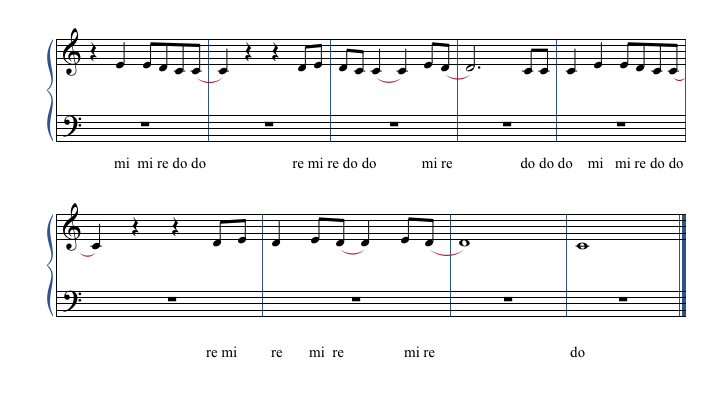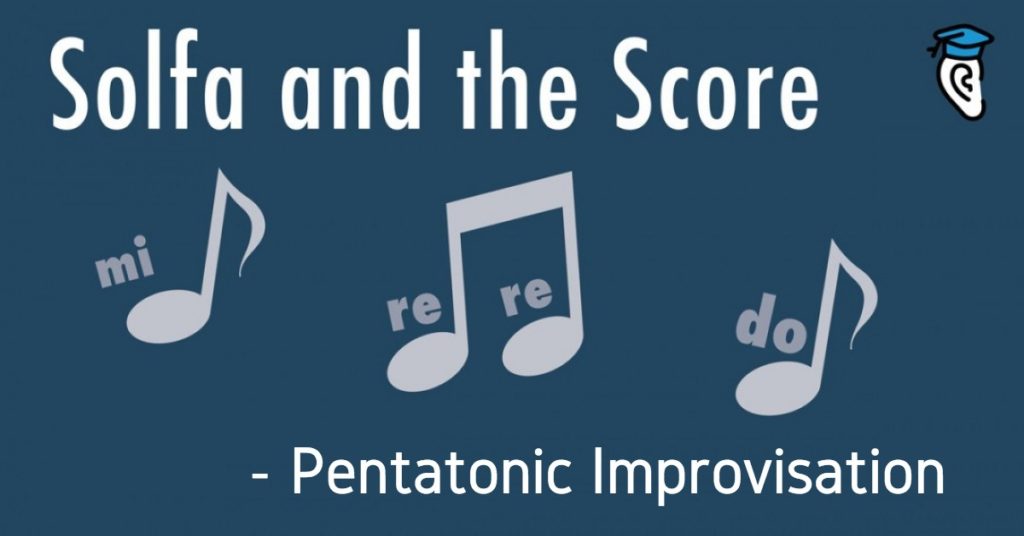Pentatonic scales have an unparalleled versatility for improvisation. Whether you use them on guitar, piano, another instrument or when singing, they provide you with a universal power to move people musically. In this article we will take advantage of their power to help you memorise the solfa syllables and their connection with the score while improvising creatively.
What is the Pentatonic Scale?
Pentatonic scales, as the name suggests, are scales comprised of five notes (“penta” meaning “five”). They are so versatile and effective that many different cultures worldwide incorporated them in their ancient ethnic music despite being geographically separated and therefore isolated from each other.

C Major Pentatonic
For example, the major pentatonic scale is the basis for virtually the entirety of the Chinese and Mongolian music tradition.
The major and minor pentatonic scales also play a prominent role in both Scottish and Andean music, even influencing the way the traditional instruments for these genres are built.
Finally, and perhaps more popular in the cultural imaginary, pentatonic scales constitute the very core of Blues and the genres derived from it: Jazz and Rock.
In all genres these five powerful notes can be used both as a source for composing new music and as a handy improvisation framework.
Speaking of pentatonic scales and improvisation, you should know that the great German composer Carl Orff (famous for “Carmina Burana”) developed a now highly popular pedagogical method named after him, “the Orff-method”, which gives a heavy focus to the power of developing creativity by improvising with pentatonic scales.
So today we will take full advantage of the power (and of course, the fun) of pentatonic scales to improvise with them, while learning the corresponding solfa syllable for each of the sounds. This will help us to create great music at the same time as becoming more proficient with remembering the note names in solfa.
Pentatonic Improvisation Exercises
We will start our improvisation training using only the first three notes of the pentatonic Do major scale in one octave: Do, Re and Mi. We will vary the rhythms and note pitches while always using these three notes and syllables. Remember, you’re not allowed to just hum the pitches! You have to sing the correct pitch name.

The backing track we will use is this one:
Here is an example of how you can improvise. Feel free to use this “lick” as initial section for your improvisation by first singing along with the example audio clip and then trying to sing it over the backing track.
Then develop it and freely create your own variations after it. Or just try different combinations until you feel completely confident using these three pitches and their respective names. The speed is 90 BPM and the time measure 4/4:

Four Note Pentatonic Practice
Same as before, but this time let’s include Sol. The tempo will be a bit slower, as the usage of an additional note demands more proficiency from you to clearly associate syllables with pitches without delay. On the other hand, you will have fewer limitations on your improvisation, as the number of melody combinations possible with four notes is much higher.

The backing track to be used is:

As you can observe, measures 2 and 3 on this example contain exactly the same notes and rhythm. Repetition is a powerful resource when you are improvising, especially when you find a combination of notes that sound interesting and fresh.
Also, if you pay a closer look, the fourth measure is nothing but a variation of the same reiterated motif, bringing a pleasant element of surprise to the audience and bringing the overall phrase to a conclusive ending. Bear in mind these tips when you are improvising to produce more musically-satisfying creations!
The Full Pentatonic Scale
Is time to use your acquired knowledge and try improvising with the full pentatonic scale. Remember, every note you would like to sign has to be accompanied by its respective syllable.
Once you are comfortable enough and can sing freely using the right syllables automatically, you will be one big step further into an advanced mastery of solfa syllables while singing.
To have the full pentatonic scale, we will add La and another Do in the octave above:

The backing track are going to use is:
The tempo for this last exercise is 62 BPM. Slower tempos mean that is possible for you to use faster subdivisions such as eighth notes and sixteenth notes. You have a full range of 5 notes now, so first concentrate in being able to explore the full pentatonic scale with the respective syllable before going further into smaller (and therefore, faster) subdivisions.
Here is a warm-up exercise you can use as inspiration:

If you have a closer look, the whole exercise presents the same structure in terms of rhythm (measures 1 and 2 have the same rhythm as measures 3 and 4), but the pitches change. This is called motif variations, and is one of the most common techniques to guarantee a coherent-sounding improvisation.
You can try as many variations as you want, but if you keep a reminiscence of the core structure, your musical ideas will always flow in a single “narrative” line. Try this in your next improvisation!
We have explored using the pentatonic scale with solfa syllables as the basis for easy sung improvisation. By limiting the number of notes available to us, we become more free to use our musical instinct as we improvise. Continue exploring the use of solfa in your own improvisation!








